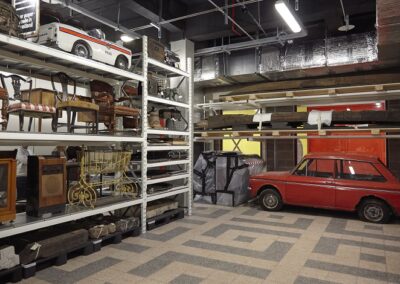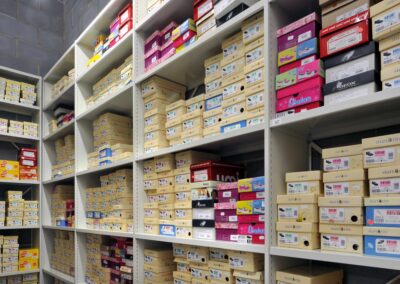When it comes to organising your storage space, whether it’s within your own home, at the office, in an archive or a back of house retail environment, choosing the correct shelves is paramount. They not only enhance the aesthetics of your space, but also maximise its functionality and capacity.
With a huge cross section of materials, weight limitations, and size considerations to bear in mind, making an informed choice can significantly impact efficiency and capacity.
Material Choices
The material from which your shelves are manufactured plays a crucial role in their overall performance and suitability. We are talking about shelving for storage and archiving, not display, so we’ve left out glass:
-
Wooden Shelves
Wooden shelves are popular for their aesthetic appeal and versatility (especially where they will be seen by the public). Timber offers durability, while engineered wood (such as MDF) provides a more affordable option. However, keep in mind that wooden shelves can have weight limitations and are not suitable for damp environments such as cold rooms.
-
Metal Shelves
Ideal for industrial or commercial settings, metal shelving is incredibly strong and capable of holding significant weight. Metal shelves are resistant to wear and tear, making them a long-lasting choice. Possibly not the best choice for a home, but for archives, industrial and business settings they’re perfect.
-
Plastic Shelves
Plastic is both lightweight and often waterproof, it is great choice for storage in places like garages or sheds. While they tend to be lighter than their metal or timber equivalents, they also have lower weight limits. Perfect for home storage where you need to move them around, not so much for industrial settings.
Consider Weight Limitations
Every shelving system comes with specific weight limitations, and understanding these is essential to preventing accidents and ensuring longevity. Talk to your supplier before committing to a system and ask them about the following:
-
Load Capacity
Check the overall load capacity of the shelving by talking to the supplier, or reading the manufacturer’s specifications. Also ensure you know the weights of the items you want to store on them. Exceeding the limit can lead to structural failure, causing damage to your inventory, causing a safety hazard and possibly invalidating your insurance.
-
Weight Distribution Guidelines
Even if the shelving can hold the weight of your items, ensure you understand the guidelines for the distribution of this weight, distributing the weight unevenly can create pressure points or imbalance that could lead breakage or tipping.
-
Understand Bracing and Support
Ensure you understand the manufacturers specifications for your application, will the shelves require bracing or anchoring? If you are looking for an application where the bracing will interfere with access, then consider another option. If you are looking at wall shelving then ensure you have a secure point to anchor to.
Review Objects, and Size Limitations
Choosing the right shelves involves more than just weight; you must also consider the dimensions of the items you intend to store. Here are a few tips to guide your selection:
-
Height and Depth
It may sound like common sense, but ensure your shelves are both tall and deep enough to accommodate the objects you plan to store without overcrowding or leaving objects precariously balanced on the edge.
-
Consider Adjustable Shelving
If you’re uncertain about what you’ll be storing, or your items are constantly changing then consider adjustable shelving units. These will allow for flexibility in spacing, accommodating items of varying heights.
-
Accessibility
Think about how frequently you’ll need to access certain items, ensure that your layouts and chosen systems allow for easy deposit and retrieval.
Maximising Your Space with Roller Racking
In addition to traditional static shelving, roller racking (or mobile shelving) is an excellent solution for optimising your space, particularly in stockrooms and archives.
These systems are much more efficient than traditional shelving units at maximising your space. Here’s why you may consider incorporating roller racking into your storage strategy:
-
Increased Storage Density
Roller racking allows you to store more items in a smaller footprint. The units do not require an aisle between each row, which can save you 70% over traditional static shelving options.
-
Improved Access and Efficiency
With roller racking, you can catalogue, and quickly retrieve items without needing to move multiple shelves or units.
-
Adaptability
Roller racking systems can be customised to fit your individuals needs. Mobile bases can be topped with a single shelving system, or multiple shelving systems (or even cupboards, drawers or anything else) to fit the needs of your inventory.
-
Protect your items
Roller racking systems are perfect for storage where items need to be kept safe. They can be fully closed, plus fitted with dust shields and locks, to keep items safe from unauthorised access and away from harmful exterior contaminants .
Conclusion
Selecting the right shelves for your premises is not just about aesthetics; it’s about ensuring safety, functionality, and practicality. By carefully considering the materials, understanding weight limitations, and being mindful of size constraints, you can create a well-organised and efficient space that meets your specific needs. Incorporating roller racking can further maximise your storage capacity, enhancing accessibility and efficiency.
If you are looking for the perfect shelving solution(s) for your premises, then check out our static and mobile shelving or get in touch below. Be sure to outline details about your premises, the items you want to store and the function required of the shelving system:









